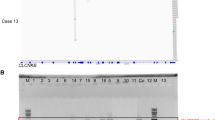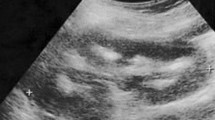Abstract
Nephrocalcinosis is a characteristic feature of both type 1 and type 2 Bartter syndrome. Bartter syndrome type 2 presents antenatally and very early in life. Late-onset presentation with isolated nephrocalcinosis is extremely rare. We describe an 11-year-old girl with incidentally detected medullary nephrocalcinosis on renal ultrasonography. She was clinically suspected to have primary hyperoxaluria based on high urine oxalate. However, clinical exome sequencing revealed a pathogenic missense variant in the KCNJ1 gene leading to the molecular diagnosis of Bartter syndrome type 2. Both parents were heterozygous carriers of the same variant. Subsequent investigations did reveal a mild Bartter syndrome phenotype with mild metabolic alkalosis, high urine chloride and high renin and aldosterone. Our case illustrates phenotypic heterogeneity of Bartter syndrome type 2 and the usefulness of genetic testing in establishing the correct diagnosis and guiding further management in such cases.


Similar content being viewed by others
Data availability
All data analyzed during publishing the case are included in this article. Further enquiries can be directed to the corresponding author.
References
Hoppe B, Leumann E, Millener DS. Urolithiasis and nephrocalcinosis in childhood. In: Geary DF, Schaefer F, editors. Comprehensive pediatric nephrology. Philadelphia: Elsevier; 2008. p. 499–525.
Devuyst O, Belge H, Konrad M, Jeunemaitre X, Zennaro M. Renal tubular disorders of electrolyte regulation in children. In: Avner ED, Harmon WE, Niaudet P, Yoshikawa N, Emma F, Goldstein SL, editors. Pediatric nephrology. 7th ed. Heidelberg: Springer; 2016. p. 1202–15.
Braun DA, Lawson JA, Gee HY, Halbritter J, Shril S, Tan W, et al. Prevalence of monogenic causes in pediatric patients with nephrolithiasis or nephrocalcinosis. Clin J Am Soc Nephrol. 2016;11(4):664–72.
Daga A, Majmundar AJ, Braun DA, Gee HY, Lawson JA, Shril S, et al. Whole exome sequencing frequently detects a monogenic cause in early onset nephrolithiasis and nephrocalcinosis. Kidney Int. 2018;93(1):204–13.
Halbritter J, Baum M, Hynes AM, Rice SJ, Thwaites DT, Gucev ZS, et al. Fourteen monogenic genes account for 15% of nephrolithiasis/nephrocalcinosis. J Am Soc Nephrol. 2015;26(3):543–51.
Richards S, Aziz N, Bale S, Bick D, Das S, Gastier-Foster J, et al. Standards and guidelines for the interpretation of sequence variants: a joint consensus recommendation of the American College of Medical Genetics and Genomics and the Association for Molecular Pathology. Genet Med. 2015;17(5):405–24.
Welling PA, Ho K. A comprehensive guide to the ROMK potassium channel: form and function in health and disease. Am J Physiol Renal Physiol. 2009;297(4):F849–63.
Vollmer M, Koehrer M, Topaloglu R, Strahm B, Omran H, Hildebrandt F. Two novel mutations of the gene for Kir 1.1 (ROMK) in neonatal Bartter syndrome. Pediatr Nephrol. 1998;12(1):69–71.
Huang L, Luiken GP, van Riemsdijk IC, Petrij F, Zandbergen AA, Dees A. Nephrocalcinosis as adult presentation of Bartter syndrome type II. Neth J Med. 2014;72(2):91–3.
Srivastava S, Li D, Edwards N, Hynes AM, Wood K, Al-Hamed M, et al. Identification of compound heterozygous KCNJ1 mutations (encoding ROMK) in a kindred with Bartter’s syndrome and a functional analysis of their pathogenicity. Physiol Rep. 2013;1(6):e00160.
Li J, Hu S, Nie Y, Wang R, Tan M, Li H, et al. A novel compound heterozygous KCNJ1 gene mutation presenting as late-onset Bartter syndrome: case report. Medicine (Baltimore). 2019;98(34):e16738.
Gollasch B, Anistan YM, Canaan-Kühl S, Gollasch M. Late-onset Bartter syndrome type II. Clin Kidney J. 2017;10(5):594–9.
Sharma A, Linshaw MA. A novel compound heterozygous ROMK mutation presenting as late onset Bartter syndrome associated with nephrocalcinosis and elevated 1,25(OH) (2) vitamin D levels. Clin Exp Nephrol. 2011;15(4):572–6.
Mansilla MA, Sompallae RR, Nishimura CJ, Kwitek AE, Kimble MJ, Freese ME, et al. Targeted broad-based genetic testing by next-generation sequencing informs diagnosis and facilitates management in patients with kidney diseases. Nephrol Dial Transplant. 2021;36(2):295–305.
Delio M, Patel K, Maslov A, Marion RW, McDonald TV, Cadoff EM, et al. Development of a targeted multi-disorder high-throughput sequencing assay for the effective identification of disease-causing variants. PLoS ONE. 2015;10(7):e0133742.
Braun DA, Schueler M, Halbritter J, Gee HY, Porath JD, Lawson JA, et al. Whole exome sequencing identifies causative mutations in the majority of consanguineous or familial cases with childhood-onset increased renal echogenicity. Kidney Int. 2016;89(2):468–75.
Connaughton DM, Hildebrandt F. Personalized medicine in chronic kidney disease by detection of monogenic mutations. Nephrol Dial Transplant. 2020;35(3):390–7.
Hay E, Cullup T, Barnicoat A. A practical approach to the genomics of kidney disorders. Pediatr Nephrol. 2021;37:21–35.
Funding
Nil.
Author information
Authors and Affiliations
Contributions
AS conceptualized the manuscript, collected clinical information and wrote the manuscript. PP did the exome sequencing, interpreted the information, produced the report and helped in writing the manuscript. KV helped in collecting clinical data and helped in writing the manuscript. SK collected the data and helped in writing the manuscript. HP corrected the manuscript. AS will act as guaranter of the article.
Corresponding author
Ethics declarations
Conflict of interest
The authors declare that they have no conflict of interest.
Ethics approval
Ethics approval was not required.
Consent to participate
Written informed consent was taken from parents for publication.
Additional information
Publisher's Note
Springer Nature remains neutral with regard to jurisdictional claims in published maps and institutional affiliations.
About this article
Cite this article
Saha, A., Pande, P., Vala, K. et al. Clinical exome sequencing uncovers an unsuspected diagnosis of Bartter syndrome type 2 in a child with incidentally detected nephrocalcinosis. CEN Case Rep 11, 417–421 (2022). https://doi.org/10.1007/s13730-022-00694-2
Received:
Accepted:
Published:
Issue Date:
DOI: https://doi.org/10.1007/s13730-022-00694-2




